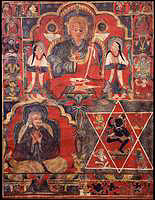
|
Guru Rinpoche Padmasambava (painting no. 160)
|

View Larger Image |
||||||||||||||
|
Guru Rinpoche Padmasambava was the greatest Buddhist mystic saint in 8th century India. He was invited by the Tibetan King Tri Song Detsen when local spirits created supranatural obstacles to the construction of Samye , the first Buddhist monastary in Tibet. After an intensive meditation retreat in Nepal he entered Tibet subduing negative energies and political obstacles to the establishment of Buddhism in the Land of the Snows. The tales of his spiritual exploits and the profound teachings he passed to the King and 24 other disciples fill thousands of volumes. He is shown here with his Indian consort Princess Mandarava and his Tibetan consort Queen Yeshe Tsogyal. Below is a portrait of a long haired lama in teaching mudra, possibly Terton King Nyima Oser; the 12th century discoverer of secret teachings Guru Rinpoche and his closest disciples buried for future discovery before he left Tibet later in the 8th century. On the right is an image of a black Trolma dakini (Skydancer) dancing in bow and arrow leg position in the midst of a Dharmakara (Tibetan: Cho Chung (Source of reality) with four other dakinis in the Dharmakara's corners. The Dharmakara is actually the three dimensional cosmic environs of the Dakinis formed by two intersecting tetrahedrons seen from above as a flat "star". One interpretation of this form is that the intersecting tri sided pyramids represent the source of reality in Buddhist symbology. The three corners of one pyramid represent the three marks of existance: suffering, impermenance and egolesseness, and the three corners of the other the three gates of liberation: wishlessness, signlessness, and emptiness. In small arcades formed by Mandorlas around the perimeter of the painting are depicted Buddhas, Bodhisattvas and sages of the Nyingma (Ancient Ones) lineage. M. Mokotoff, 11/97
|
|||||||||||||||
Photographed Image Copyright © 1998 Shelley & Donald Rubin Foundation
|
|
| |
Next Image |